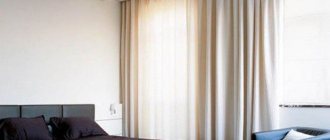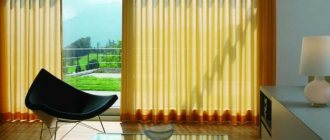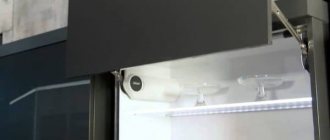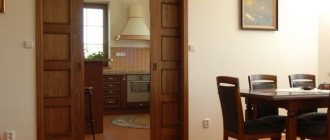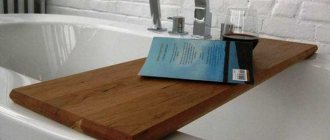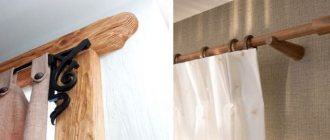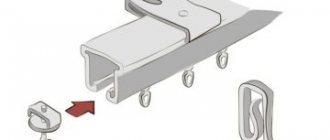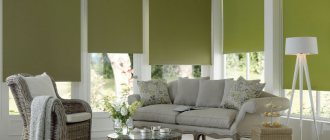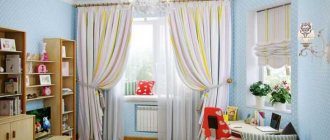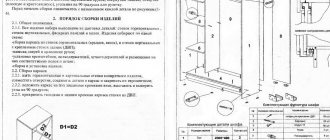Many of us are familiar with the term “cornice”. Most of all, it is associated with a horizontal crossbar installed above a window opening, on which curtains and curtains are hung. Although this word has several meanings, including a ledge above a door, a ledge on a wall that serves as a support for the roof and protection from rain, a ledge on a mountain slope, etc.
In an apartment, a cornice tends not only to perform an aesthetic function, fitting harmoniously into the interior, but to be reliable and functional. One of the latest original innovations that appeared in the conditions of progress and actively flooded the construction industry market was flexible curtain rods. Thanks to them, the interior composition of the room receives a certain originality and, at the same time, completeness and harmony. This non-standard solution allows you to emphasize the refined taste of the owners and create comfort and coziness in the house.
Flexible curtain rods: what does the new product look like?
This is a strip, in other words, a rail structure. It is based on a flexible polymer or aluminum profile, usually 6 meters long (also found in other size variations), which can be easily cut across to the required size and, if necessary, extended using special inserts. Most options bend easily by hand. Some require the use of a special machine.
Thanks to the color scheme, plastic will suit any room interior, and an aluminum cornice can emphasize the strict style of the room. The system is produced with external or internal rail. The internal rail allows you to completely hide the structure behind the drapery. External is more flexible. To ensure the so-called wavy or semicircular bending, as a rule, the strip profiles are single-row.
Design Features
So, what is this miracle cornice that can turn any interior into a masterpiece of design art?
A flexible curtain rod is used in cases where it is not possible to use traditional curtain rods to attach curtains.
This is a flexible tape 6 meters long. Such a cornice can be cut across into any lengths; this will not in any way affect its design features, technical characteristics or appearance.
The profile cornice consists of grooves and fasteners.
By purchasing a flexible curtain rod, you receive a set of the following elements:
- Profile;
- Calipers that help fix the structure in the position you need;
- Plugs that are attached to the sides of the cornice;
- Bracket, thanks to which the distance between the cornice and the wall is adjusted;
- Hooks for attaching curtains. They have a two-row arrangement: those that are lower are for tulle, and those that are higher are for curtains.
The flexible tape can be cut crosswise to the desired size.
Some models are additionally equipped with an extension cord that allows you to extend the structure to the desired length.
Method of fastening flexible curtain rods
Despite the flexibility, the inherent vertical rigidity of the profile will not allow the structure to fall along with the curtains; the main thing is to fix it securely. You can hang the cornice both on the wall and on the ceiling using modern supports and brackets. They are made and attached in such a way that they do not interfere with the free sliding of the runners along the bar. The brackets are capable of adjusting an 8-25 cm distance from the wall. If there are PVC ceiling coverings in the room, wall cornices (stretch ceilings are not intended for any kind of fixation) are the best way out of the situation. By the way, if the room is small, “stuffy”, the ceiling cornice system will visually make the room taller.
Types of ceiling cornices
Rotating corner of a double-row cornice with a decorative overlay on the front side
Cornices are classified by profile level into single-row, double-row and three-row, as well as by the material from which they are made. These two parameters are interrelated. After all, its strength, design and number of rows depend on what material the cornice is made of.
Cornices are classified into:
- Metal. Cornices made of this material are attached to the ceiling or walls. Often such products are decorated, covered with gold or chrome, and decorated with engraving. Durable, as a rule they are made of light metals (aluminum, copper). The profile is usually a three-row ceiling cornice, less often two and single-row.
- Plastic. Such products are lightweight and can be easily bent into any shape. Decorative elements are rarely applied to them, since plastic is not as durable a material as wood or metal. In terms of profile, these are predominantly single-row ceiling cornices. Cornices made from this material are more suitable for rooms decorated in high-tech style.
- Wooden. They are made from both simple (oak, pine, walnut) and expensive wood species (red, black, sandalwood). Most often, by design, this is a double-row ceiling cornice. They are suitable for almost any room, but some difficulties are possible during installation, since wood is a natural material and has its own characteristics. For example, pine is a very soft material, and when attaching it to the ceiling, you should not overtighten the screws so that tears or cracks do not appear.
Design features
Forged metal double-row cornices in various colors
A cornice is a prefabricated structure that consists of several parts. The main elements are the rows themselves, the visor and fastenings.
According to the design features of the rows, they are divided into:
- Forged. There are single, double and triple, with pipes and with strings. Control is mainly manual - using a cord or a pointer handle. They are often equipped with special equipment - a carriage with a cord. Using the carriage, you can move and move curtains apart. The price for such models is the highest on the market, but the strength of all elements included in the product is also higher.
- Round. In appearance, such a kit consists of ordinary pipes and brackets. Most often this is a single-row ceiling cornice, with one pipe, but there are also two-row and three-row models. The pipes of such cornices are made of wood, metal or plastic.
- Strings. These curtain rods use string instead of pipe. The only drawback is the low strength of the structure. As a rule, this profile design is usually single-row ceiling cornices.
- Baguettes. All elements of the cornice, pipes or strings, fastenings, brackets are hidden behind a decorative visor. This part can be of any shape, color, texture and pattern. The profiles of such products can be single-row, double-row and three-row.
How are curtains attached to the curtain rod?
The fastening element with which the curtains are attached and silently move along the cornice are multifunctional two-tier hooks and runners with a wheel. They are inserted into the grooves on the profile. The bottom hooks are designed for tulle, curtains, they have a low comb. The upper ones are with a high scallop, they are lambrequin, completely cover the cornice, and are also needed for heavier curtains and drapes. They are able to withstand the daily load when opening the curtains and their sufficient weight, since they are reliably protected from breaking.
To prevent the runners from jumping out of the profile, manufacturers ensure that special flat-foot plugs are supplied complete with the cornice, including spare ones, which are also equipped with hooks for lambrequins and fixing the edge of the curtain fabric. The longer the cornice, the more plugs and hooks and runners are attached to it. If necessary, all components can be purchased additionally.
Cornices in Leroy Merlin and product reviews
Of course, before you start installing the cornice, you first need to buy it. Leroy Merlin construction hypermarkets are considered an excellent place for such a purchase.
At the same time, given that the choice there is simply huge, it may be more convenient for you to study the product catalog remotely, select the desired product and order it. The prices are very reasonable and, as a rule, no one has any problems with delivery.
By the way, one of the most popular flexible ceiling structures is considered to be “Comfort”, reviews of which say that it:
- Very easy to use - the curtains slide easily and without tension;
- Installation is very simple, according to the instructions included in the kit;
- The material is durable, but cuts easily;
- It has a compact, convenient packaging.
However, you should keep in mind that the package does not include a decorative tape covering the sliders. If you want to have a closed cornice, you will have to purchase additional components.
Any windows will become more elegant and beautiful if you decorate them with a curved cornice with delicate curtains or chic heavy curtains and lambrequin. Using a flexible design, you can create an interesting, unusual interior that will give the room warmth and comfort.
Qualitative characteristics of flexible cornice: advantages and disadvantages
Flexible curtain rods are characterized by:
— strength (aluminum curtain rods can withstand weight up to 50 kg);
- elasticity, the ability to take a curved (wavy and zigzag, spiral), be it angular or smooth position, configuration at different radii (plastic can withstand bends up to 90º); you can aesthetically hide protruding pipes and smoothly bypass all protrusions thanks to the horizontal flexibility of the profile;
— ease of installation (you don’t need to spend money on calling a specialist; you can do the fastening yourself, enjoying the work);
— practicality and ease of use (drapery is easy to hang and slides freely along the guides);
- the ability to build a multi-layer composition of curtains and tulle, installing a couple of structures if necessary;
— low maintenance (easy to clean from dust);
— compactness during transportation (many models are supplied in small boxes, rolled into a ring);
- optimal ratio: price - quality, although aluminum structures are somewhat more expensive than plastic ones;
As for the shortcomings, a flexible aluminum cornice, as well as a polymer one, is more likely to hide flaws in the interior, so this is a real find for designers and people with taste. Although customer reviews indicate that an aluminum profile can withstand more weight than a plastic one.
Features of installing a ceiling cornice
Installing a ceiling cornice has some difficulties. Since the ceiling fabric will be stretched over the fastening structure, and access to it will be blocked, it is very important to take all measurements correctly and complete all the work. The main difficulty is that during installation, wooden blocks are used as embedded parts, and therefore, if oxygen access is difficult, they can begin to rot, and the entire suspended structure will lose strength. The second problem that often arises when the curtain rod is installed incorrectly is difficulty moving the curtains. The reason for this is incorrect calculations and tight contact with the tension fabric.
Installation of a hanging system for curtains on a suspended ceiling is done in two ways:
- Open. In this case, the profile of the cornice remains visible. This method of fastening is simpler and faster.
- Closed. The entire structure will be hidden behind the tension fabric, which will give the impression that the curtains are flowing from the ceiling itself.
Open type of fastening
Installing a cornice on a suspended ceiling consists of the following steps:
- In the place where the cornice structure will be mounted, an embedded part is initially installed - a small wooden block. It is attached directly to the base base of the ceiling - to a concrete slab. It is important that it does not put pressure on the canvas and is treated with special compounds that protect it from rotting.
- After the beam is secured, the tension fabric is installed. At the same time, in those places where the cornice will be attached to the beam, special reinforcing rings are glued, inside of which holes are made in the canvas. Moreover, it is recommended not to cut out the latter, but to burn it in order to prevent the PVC film from diverging.
- The cornice is attached to the block through the holes in the rings.
Hidden installation
The hidden type of curtain rod installation allows you to hide all fastening elements and create a beautiful effect of flowing curtains from the ceiling itself. However, it is much more difficult to implement; in addition, it is necessary to additionally create a niche where the structure will be hidden. But an additional advantage of this is that in the niche you can install lighting with LED strips, which will beautifully highlight the curtains and give a bright accent to the interior of the room.
Niche installation
The installation of the niche should be entrusted to the craftsmen who will install the stretch ceiling. Its recommended width is 10-15 cm. The cornice is attached directly to the concrete base of the base ceiling inside this niche.
- Along the entire perimeter of the room, with the exception of the wall where the window opening is located, a baguette is attached, due to which the ceiling level will be lower than the standard one.
- A wooden beam or profile is attached parallel to the wall with the window inside the proposed niche, to which a baguette will also be mounted in the future.
- The ceiling cornice is installed on the dowels.
- The canvas is stretched over the mounted baguette.
Creating a niche in a suspended ceiling for a cornice with a bend
The technology for installing a cornice with a bend is in many ways similar to the previous version, except that corners are attached to the base base with dowels in increments of 70 cm, onto which a wooden beam or aluminum profile with a bumper is then installed, through which the stretch ceiling fabric will bend.
Application
Flexible curtain rods are quite relevant in rooms of non-standard sizes with high and wide window openings. We are talking not only about urban and suburban residential buildings, but also about public places and office premises. They allow you to decorate arched, corner, inclined, asymmetrical windows, balconies and loggias of semicircular, oval shapes, zone the space of children's and living rooms, install screens and canopies in bedrooms, and are applicable in bathrooms.
In addition, it has recently become uncommon in the construction of modern studio apartments to resort to a bay window, which was quite popular at the beginning of the last century - a protruding part from the plane of the wall. Bay windows require an individual decorative approach, which involves the use of unusual curtain fabrics. And you will have to start by choosing a cornice design. Flexible bay window cornices are a good choice for these purposes. It is also possible to use forged, round, string, baguette systems. Some of them are characterized by a hinged connection of the slats, which does not always allow the curtains to move unhindered. Installing a flexible bay window cornice will cause less hassle and will look very, very elegant.
Curtain fastening
Fastenings for curtains are carried out in various ways, the most common options are:
- Curtain tape - sewn along the top edge of the curtain and equipped with a cord for adjusting the length of the curtain. May have one or two rows of loops.
- Eyelets are metal or plastic rings that are installed on holes in the fabric.
- Hooks. They are not aesthetically pleasing, but are almost always hidden behind the front decorative panel.
- Metal or plastic rings, unlike eyelets, are installed along the top edge of the fabric.
- Fabric loops.
Now you can easily attach curtain rods. We hope the question of how to install curtain rods will no longer arise.
Preparing the cornice structure for installation
To hang a cornice, you do not need any special knowledge, skills or effort. Detailed instructions are supplied with the cornice, which will facilitate the installation process of the product. Standard installation techniques involve several preparatory steps. Firstly, this is the selection of the necessary tools (a tape measure, a level, a screwdriver or an ordinary screwdriver, a drill, a hacksaw may be useful). Secondly, the preparation of safe support (table, chair, stepladder), since work, as a rule, is carried out under the ceiling, higher than a person’s height.
Material of manufacture
Flexible plinth is made from polyurethane, which combines under one name many polymer materials that differ from each other in chemical properties, as well as functional characteristics. Polyurethane is known to ordinary people as a rubber substitute.
The elasticity and strength of polyurethane ranges from dense plastics to soft rubber. All of them are immune to aggressive environments, are wear-resistant, and serve in the temperature range from -60 to +80 degrees.
Caring for polyurethane skirting boards is simple and does not require special skills: the product is easy to wash, clean with cleaning products, even small abrasives can be used (with the exception of colored cornice).
Installation rules
You can install flexible curtain rods yourself. This does not require special skills or experience. Prepare the site for the structure in advance. The ceiling or walls must be clean and smooth. To work you will need the following tools:
- screwdriver;
- perforator;
- drill;
- building level;
- self-tapping screws;
- tape measure and pencil.
Usually the package contains instructions and a diagram for assembling the cornice. First, draw a line with a pencil on the ceiling or wall along which the tape will be laid. Using a puncher or drill, drill holes at equal distances. Dowels are inserted into them, calipers and brackets are attached. A flexible cornice with attached hooks is fixed on them. Self-tapping screws are inserted into the holes and screwed in with a screwdriver.
After this, you can hang curtains and curtains on the structure. If only translucent tulle is attached to the cornice, then the product itself can be fixed using construction glue. This will reduce installation time.
Criterias of choice
The curtain not only carries a functional load, that is, it closes the window from the penetration of sunlight or limits the view of the room, but also has an aesthetic purpose - decorating the window and creating a cozy atmosphere in the room. Therefore, against its background, the cornice should look harmonious.
Modern flexible curtain rods made of plastic profiles have a fairly large color palette and therefore harmonize with any interior. Aluminum analogues fit very well, for example, into a modern style or other simple style interior. To be able to hide the structure behind the fabric, choose the option with an internal rail. If flexibility is important, then a single-row model with an external rail is used. When choosing a curtain rod, it is important to consider what will hang on it. If you expect to have curtains and curtains, then you need to choose a double-row cornice.
Cornices are also selected according to the method of fastening. Depending on the design solution, ceiling or wall installation methods are used.
Main stages of installation
It has already been noted that there are the following methods of attaching a cornice: wall and ceiling. The most common method of installing flexible curtain rods is the ceiling installation option. According to reviews, this option is most suitable for low ceilings, which means in most apartments on the secondary housing market.
The sequence of operations that are performed during installation is as follows:
- We take measurements and make marks at the place where the cornice is installed;
- we make holes for installing fasteners, the distance between them is half a meter;
- We install fasteners;
- we fix the flexible cornice on the brackets;
- hanging the curtains.
More detailed information can be found in the attached video.
Wall mounting of the cornice is done in exactly the same way, only the brackets are attached to the wall. This type of installation of the structure is used for suspended ceilings, if special niches are not provided for installing curtains or a two-row profile is needed, but there is no space for it.
Self-installation
The photo shows a window design option with a plastic system mounted on the ceiling
Today, flexible curtain rod systems are very popular among designers. Of course: such practical fasteners allow not only to correctly design windows of complex geometric shapes, but also to give the most ordinary opening a unique appearance. Therefore, it is not surprising that many craftsmen wondered how to attach a flexible cornice to the ceiling?
It turns out that special skills and knowledge are not required to implement the original idea. The main thing is to choose the right materials and follow the recommended work plan.
Tools and procedure
To firmly secure flexible ceiling cornices, you will need:
- drill (preferably with impact function);
- pencil and level;
- hacksaw for metal;
- self-tapping screws;
- set of profile and additional elements.
Important! Drilling monolithic ceiling tiles is not an easy task. A powerful impact drill and the right drill bit will make the job easier.
You don’t need to be a professional to install a bendable system!
The installation instructions for flexible profiles recommend performing work in the following order:
- Mark on the ceiling the area where the cornice will be installed, taking into account the shape it will be given.
- Attach the profile, bending it in the desired places. Carefully cut off the excess length using a hacksaw.
- After about 40-50 cm, drill holes for the supports and secure the latter to the ceiling.
- Assemble the profile by putting runners and caps on the edges.
- Snap the cornice onto the bracket and hang the selected curtains with pre-attached hooks onto the profile.
The presented scheme of actions is absolutely identical both when decorating windows and when creating other decorative structures. Moreover, the weight of the curtains used can be very large: aluminum profiles can easily support even 50-kilogram curtains.
Note! If you plan to use exclusively light fabrics, the drilling step can be increased to 60-70 cm.
Wall mount: important nuances
Correct preliminary measurements will save you from problems in the future
In some interiors, a bending cornice is fixed to the wall. Most often, this solution is typical for tall but narrow rooms. It is also relevant if it is impossible to drill through the ceilings.
For wall mounting, you will need a similar set of tools. However, be careful: a flexible system requires not only edge support points, but also central support points. This is the only way to ensure that the curtains are held securely in place.
In this option, experts recommend fixing the brackets at a distance of at least 50 centimeters from each other. If the curtains are planned to be particularly heavy, reduce the intervals to 30 cm.
Wall mounting also requires multiple support points
Interior
In children's rooms and bedrooms, a canopy cornice is often used. A translucent fabric suspended above the bed gives a feeling of peace, protects from annoying insects, and decorates the room.
For doorways, flexible cornice structures are used together with decorative accessories in the form of beads and ribbons.
It is ideal to use flexible elements in studio apartments to delimit the space into separate zones. If you do this in the kitchen, it is advisable to use synthetic fabrics, which absorb odors less than natural ones.
Also, elastic curtain rod structures have found application in the bathroom. If it is spacious, a patterned cornice looks appropriate and attractive, and a waterproof curtain hung on it reliably protects from splashes.
But the most popular place to use flexible consoles is, of course, the living room. Using an elastic product, they create a non-trivial interior with a comfortable aura. The functional characteristics of the element allow you to reliably hide heating pipes, while bending around wall recesses and projections of the room.
WATCH VIDEO INSTRUCTIONS
Flexible curtain rods and curtains that are attached to them give designers the opportunity to create a non-standard room style.
Home / Components and accessories / How to make a hidden cornice with your own hands?
Curtains are one of the most important elements of almost any interior. In order to secure them in the window opening, a cornice is needed, however, it is not always possible to choose exactly the kind of curtain that will fit into the existing design and become a full-fledged part of it. In this situation, a hidden cornice that you can install yourself will help out.
Types of products
Profiles are divided according to the type of fastening into ceiling and wall. They are installed in the same way, so the choice depends only on the preferences of the owner of the premises and future operating conditions. Ceiling products are suitable for dividing a room into several zones.
Designers recommend using such models in small apartments. Wall cornices significantly reduce the size of the room. You can create a more airy environment using a thin design and a light chiffon curtain.
Based on the number of rows, multi- and single-row products are divided. The latter are classic profiles for window decoration. Double-row structures are necessary in large houses with balconies. Several combined cornices allow you to hang 2-3 chiffon curtains, curtains made of heavy fabrics, lambrequins, curtains made of beads and beads.
Classification of structures by shape:
- straight or tape;
- semicircular;
- arcuate;
- rounded.
The flexible profile is considered universal. In addition to practical benefits, it has a laconic appearance. Popular systems with rounded ends allow you to create an atmosphere of semi-darkness in rooms. You can close the thick curtains not all the way, which will allow light to penetrate into the bedroom. For attics, arched and bay windows, arched curtain rods, as well as semicircular structures, are suitable.
How to beautifully drape a panel?
In order for the curtain panels to form beautiful folds, you need to know how to properly hang the curtains on the cornice. The stick and string devices have rings and clips for this purpose, and the profile one is equipped with hooks. The curtains are attached to the curtain rods using these elements: the hooks can be inserted into the loops, and the clips and rings are equipped with clamps.
But in order for the curtain to lie in even waves, it is not enough to simply attach it to the cornice. Folds need to be laid either when sewing or when hanging curtains from the ceiling. In order to make a wave or gather when sewing, take 1.5-2 times more material than required by width measurements. You can make drapery when sewing like this:
- Sew curtain braid to the wrong side of the panel. It consists of a fabric tape through which strong threads are pulled. The sewn braid needs to be collected by pulling out these threads. As a result, the canvas will acquire a neat gather along the upper edge and form lush small folds.
- On the fabric, mark places for folds (counter, bow, one-sided), fold the material as required for this, and stitch it.
To hang draped curtains, you can use any type of fastener.
Folds on tulle
When hanging curtains with a straight panel, proceed differently. There is an old way to hang tulle to make the curtain look fuller. This requires an odd number of rings on the cornice. First, the tulle must be attached along the edges with 2 rings on the left and right. In this case, the sides are turned towards the window by 5-7 cm and 2 layers of fabric are clamped with a clip at once. Next you need to disassemble the rings into 2 sides. There will be 1 ring left in the center.
Find the middle of the curtain, make a small fold and secure it with a clip. On each half of the panel, do the same steps: disassemble the rings, find the center, secure with a fold. Do this until the entire top of the curtain is folded. Then stretch the tulle along the cornice.
Folds on the curtain
Even folds on a curtain suspended on a rod or string cornice can be made using the same pattern. But what if a profile cornice with hooks is installed? In this case, curtain braid will help to secure the curtains beautifully.
It needs to be sewn to the back side of the panel, but not pulled together, but use the loops that are on it. It is more convenient to first insert the hooks into the eyelets, and then hang the curtains on the ceiling cornice. Measure 10 cm from the side of the curtain and insert the hook. Bend the edge of the curtain so that this fastening element becomes the last one, and put the loop on the edge of the tape onto 1 hook with the one next to it. Do the same on the other side.
The remaining loops along the entire length of the tape should be put on hooks in pairs. As a result, the entire panel will be collected into uniform, regular folds. Their depth and number depend on how to combine the loops: in a row or with 1-2 gaps.
If the curtains on the ceiling cornice are hung correctly (with neat draping or gathering), then the appearance of the curtain will be ideal. Curtains that hang vertically can be given volume by tying them with tiebacks. Thin curtains can be sewn in the Austrian or French style, with scallops. All these techniques help to elegantly decorate windows.
